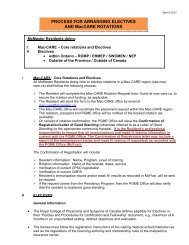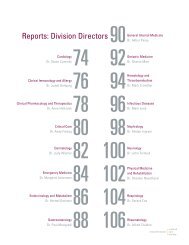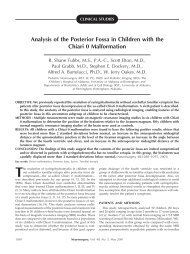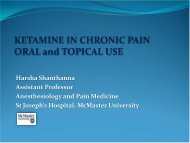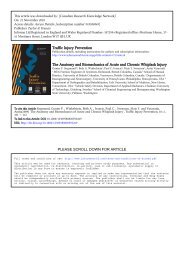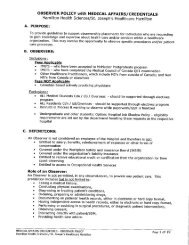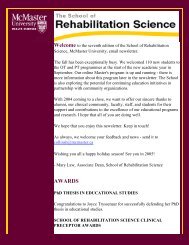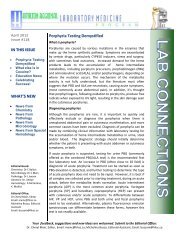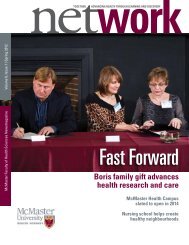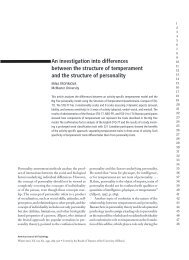Power-Mobility Indoor Driving Assessment Manual (PIDA)
Power-Mobility Indoor Driving Assessment Manual (PIDA)
Power-Mobility Indoor Driving Assessment Manual (PIDA)
You also want an ePaper? Increase the reach of your titles
YUMPU automatically turns print PDFs into web optimized ePapers that Google loves.
ACKNOWLEDGEMENTS:<br />
<strong>Power</strong>-<strong>Mobility</strong> <strong>Indoor</strong> <strong>Driving</strong><br />
<strong>Assessment</strong> <strong>Manual</strong><br />
(<strong>PIDA</strong>)<br />
Deirdre R. Dawson, PhD, OT Reg. (ON)<br />
Ethel Kaiserman-Goldenstein, BOT, OT Reg. (ON)<br />
Roberta Chan, MSc, OT Reg. (ON)<br />
Janet Gleason, MSc, OT Reg. (ON)<br />
The development of the <strong>Power</strong>-mobility <strong>Indoor</strong> <strong>Driving</strong> <strong>Assessment</strong> and the manual was<br />
made possible with the enthusiastic support of a great many individuals. The <strong>PIDA</strong> was<br />
developed in collaboration with the Department of Occupational Therapy, Extended<br />
Care Division, at the Sunnybrook Health Science Centre, Toronto, Canada (now<br />
Sunnybrook & Women’s College Health Sciences Centre). The following occupational<br />
therapists were involved: Rebecca Bair-Patel, Cathy Balsdon, Bev Moskovic, Eunice<br />
Podolski, Barbara Skulko, and Ruth Young. The additional efforts made by a number of<br />
these individuals needs special mention. Cathy Balsdon and Barbara Skulko were<br />
involved in the data collection for the reliability study. Barbara Skulko and Ruth Young<br />
provided editorial comments on the entire manual. The authors express their gratitude<br />
to each of these individuals.<br />
We would also like to thank occupational therapists across Canada who participated in<br />
a mailed survey as part of the content validation for the <strong>PIDA</strong>. Their comments were<br />
invaluable.<br />
Finally, we would like to acknowledge the Ontario Society of Occupational Therapists’<br />
Research Fund. The research on the <strong>PIDA</strong> was accomplished in part through their<br />
financial support.
INTRODUCTION<br />
<strong>PIDA</strong> ©2006<br />
The <strong>Power</strong>-mobility <strong>Indoor</strong> <strong>Driving</strong> <strong>Assessment</strong> (<strong>PIDA</strong>) is a valid and reliable<br />
assessment designed to assess the indoor mobility of persons who use power chairs or<br />
scooters and who live in institutions.<br />
The instrument was developed to be used clinically, to guide intervention plans. It was<br />
designed with two purposes in mind; to describe and evaluate. That is, it has been<br />
designed to describe an individual’s mobility status at a single point in time indicating<br />
where and how interventions may be made and it was designed to evaluate change<br />
over time. Thus, it should register improvement following an intervention, for example a<br />
training program or environmental modification.<br />
The instrument has been designed to measure only mobility status and not the level of<br />
function on other self-care activities. Thus, in a number of places in the assessment the<br />
client is asked to approach an object in preparation for using it (e.g. toilet) but actual use<br />
of it (transfer, hygiene) is not tested. Self-care activities should be covered in a more<br />
specific self-care assessment, for example the Functional Independence Measure or<br />
the Barthel Index.<br />
The <strong>PIDA</strong>’s design reflects occupational therapy theory. In Toward outcome measures<br />
in occupational therapy 1 it is clearly stated that performance should be measured in<br />
relation to the environment and roles. This assessment reflects this by scoring clients<br />
only on items that are in their environment and/or are necessary for them to do. The<br />
“not applicable” category provides the <strong>PIDA</strong> with the client-centered focus, which is an<br />
integral part of occupational therapy.<br />
The rigorous development included an extensive literature review, review of other<br />
assessments, and feedback from occupational therapists across Canada. This<br />
methodology established the content validity of the <strong>PIDA</strong>. Test-re-test reliability and<br />
inter-rater reliability were confirmed using fifteen drivers and three occupational<br />
therapists as raters. The intra-class correlation coefficient for test-re-test reliability was<br />
0.67 (p
<strong>PIDA</strong> ©2006<br />
many experiences with clients who have visual-perceptual and/or cognitive<br />
impairments, yet have satisfactorily completed the <strong>PIDA</strong> and drive independently within<br />
the facility.<br />
1 Department of National Health and Welfare, & Canadian Association of Occupational Therapists (1987).<br />
Toward outcome measures in occupational therapy. Ottawa: National Health and Welfare.<br />
2 Dawson, D., Chan, R., & Kaiserman, E. (1994). Development of the <strong>Power</strong>-mobility <strong>Indoor</strong> <strong>Driving</strong><br />
<strong>Assessment</strong> for residents of long term care facilities. Canadian Journal of Occupational Therapy, 61,<br />
269-276.<br />
©Dawson, Kaiserman, Chan & Gleason, 1995, 2006 3
POWER-MOBILITY INDOOR DRIVING ASSESSMENT<br />
MOBILITY DEVICE AND DRIVER EXPERIENCE CHECK LIST<br />
Driver Name: ____________________________<br />
<strong>Assessment</strong> Date: _________________________<br />
Assessor’s Name: _________________________<br />
TYPE OF MOBILITY DEVICE:<br />
• Trial device: " Client owned: "<br />
<strong>PIDA</strong> ©2006<br />
• Make and model:_____________________________________________________________<br />
• Seating system: _____________________________________________________________<br />
• Type of controls: ____________________________________________________________<br />
• Special adaptations: __________________________________________________________<br />
USE OF DEVICE SAFETY ACCESSORIES:<br />
Please check all accessories that are currently used. Indicate those that are needed with a star.<br />
_____ flag _____ lights _____ anti-tippers<br />
_____ reflectors _____ seat belt _____ horn<br />
_____ rear view mirror _____ other (specify)<br />
Is the driver able to explain or demonstrate how each accessory is used: YES "NO "<br />
DRIVING EXPERIENCE:<br />
• Years _____________________________________________________________________<br />
• Devices used currently/in the past _______________________________________________<br />
• Environment/facility (briefly describe) ___________________________________________<br />
CAN THE CLIENT…<br />
• Turn device on/off YES NO N / A<br />
• Utilize braking system YES NO N / A<br />
• Disengage braking system YES NO N / A<br />
• Use speed control switch YES NO N / A<br />
• Use special features of device YES NO N / A<br />
• Request assistance if necessary YES NO N / A<br />
• Independent transfer on/off YES NO N / A<br />
©Dawson, Kaiserman, Chan & Gleason, 1995, 2006 4
<strong>PIDA</strong> ©2006<br />
If no, describe transfer:_________________________________________________<br />
Sitting tolerance: _______________________________________________________________<br />
COMMENTS AND OTHER RELEVANT INFORMATION:<br />
©Dawson, Kaiserman, Chan & Gleason, 1995, 2006 5
ASSESSMENT SCORING<br />
Each item on the <strong>Power</strong>-mobility <strong>Indoor</strong> <strong>Driving</strong> <strong>Assessment</strong> (<strong>PIDA</strong>) is scored as follows:<br />
4 Completely independent: optimal performances, able to perform task in one attempt<br />
smoothly and safely.<br />
<strong>PIDA</strong> ©2006<br />
3 Completes task hesitantly, requires several tries, requires speed restriction, and/or bumps<br />
walls, objects etc. lightly (without causing harm).<br />
2 Bumps objects or people in a way that causes or could cause hart to the client, other<br />
persons, or to objects<br />
1 Unable to complete task – reason: ___________________________. For example, may<br />
require verbal and/or visual cues or physical assistance.<br />
Total Score = Sum of scores for each applicable item x 100 = ______ %<br />
4 x (Number of applicable items)<br />
Please note: The total score does not represent a percentage of normal. Rather, it provides a<br />
number which may facilitate comparing performance over time.<br />
©Dawson, Kaiserman, Chan & Gleason, 1995, 2006 6
POWER-MOBILITY INDOOR DRIVING ASSESSMENT (<strong>PIDA</strong>)<br />
INSTRUCTIONS AND SCORING CRITERIA<br />
BEDROOM<br />
<strong>PIDA</strong> ©2006<br />
1. Accessing Bed from Client’s Right Side:<br />
Instructions: “Please park on the right side of the bed so that you can move from the chair to the<br />
bed directly.”<br />
Criteria: Ability to manoeuvre wheelchair to access bed for transfer. Depending on type of<br />
transfer used, client may need to touch bed.<br />
2. Accessing Bed from Client’s Right Side:<br />
Instructions: “Please park on the left side of the bed so that you can move from the chair to the<br />
bed directly.”<br />
Criteria: Ability to manoeuvre wheelchair to access bed for transfer. Depending on type of<br />
transfer used, client may need to touch bed.<br />
3. Approaching the Dresser:<br />
Instructions: “Please approach your dresser as if to open your top drawer or reach something<br />
from its surface.”<br />
Criteria: Ability to position oneself effectively to access the dresser drawers or reach something<br />
from the surface.<br />
4. Approaching Bedroom Closet:<br />
Instructions: “Please approach your closet as if you or someone else was going to open the<br />
door.”<br />
Criteria: Ability to position oneself effectively to open or allow someone else to open closet<br />
door.<br />
BATHROOM<br />
N.B. Test in the bathroom the client would normally use.<br />
5. Through Bathroom Doorway:<br />
Does the client normally open the bathroom door themselves? _____YES ______NO<br />
Instructions if yes: “Please open the door and drive into the bathroom”<br />
Instructions if no: “Please drive into the bathroom.”<br />
Criteria: Ability to open door, and drive into the bathroom navigating around the door if this is<br />
part of the normal routine.<br />
©Dawson, Kaiserman, Chan & Gleason, 1995, 2006 7
6. Approaching the Sink:<br />
Instructions: “Please approach the sink as if to use it.”<br />
Criteria: Ability to access the sink.<br />
7. Approaching the Toilet:<br />
Instructions: “Please position the chair as if you were going to use or move to the toilet.”<br />
<strong>PIDA</strong> ©2006<br />
Criteria: Ability to manoeuvre the vehicle in the bathroom for bowel and bladder management.<br />
8. Exiting the Bathroom:<br />
Does the client normally close the bathroom door themselves? _____YES ______NO<br />
Instructions if yes: “Please leave the bathroom and close the door”<br />
Instructions if no: “Please leave the bathroom.”<br />
Criteria: Ability to exit the bathroom and close the door if this is part of the normal routine.<br />
9. Automatic Sliding Doors-mat trigger:<br />
Instructions: “Please drive through the doorway”<br />
DOORS<br />
Criteria: Ability to go through the doorway changing speed if necessary.<br />
10. Automatic Swing Open (towards the person) Doors – “mat trigger”<br />
Instructions: “Please drive through the doorway”<br />
Criteria: Ability to leave space for door to open and go through the doorway changing speed if<br />
necessary<br />
11. Automatic Doors – button trigger:<br />
Instructions: “Please push the button and drive through the doorway.”<br />
Criteria: Ability to push the button and go through the doorway.<br />
12. Narrow Regular Doors: N.B. This item is tested on the narrowest door the client uses.<br />
Does the client normally open this door? _____YES ______NO<br />
Instructions if yes: “Please open the door and drive through.”<br />
Instructions if no: “Please drive through this doorway.”<br />
Criteria: Ability to go through the doorway, opening the door first if this is routine.<br />
©Dawson, Kaiserman, Chan & Gleason, 1995, 2006 8
ELEVATOR<br />
<strong>PIDA</strong> ©2006<br />
N.B. Before beginning this portion of the test, advise the client that if they need assistance with<br />
the elevator button or door they are expected to ask for it.<br />
13. Entering Door:<br />
Instructions: “Please enter the elevator.”<br />
Criteria: Ability to enter elevator. Therapist may hold the door if asked.<br />
14. Spacing in Elevator:<br />
Instructions: No instructions to the client. If there are no people in the elevator, therapist enters<br />
first. Observe client in the elevator.<br />
Criteria: Ability to space self safely in the elevator.<br />
15. Exiting the Elevator:<br />
Instructions: “Please exit the elevator.”<br />
Criteria: Ability to exit the elevator. If exiting in reverse, client is expected to look around to<br />
ensure nothing is in the way. Therapist may hold the door if asked.<br />
16. Parking at a Table with Limited Space:<br />
Instructions: “Please park under that table.”<br />
PARKING<br />
Criteria: Ability to park in a one metre (3 feet) space at a table, either between two persons or<br />
between 1 person and a table leg, without knocking another or the table. The table should be one<br />
normally used by the client and the comment should indicate the type of table tested.<br />
17. Parking beside a Table:<br />
Instructions: “Please park beside that table close enough to enable you to reach items on the<br />
table.”<br />
Criteria: Ability to park beside a table close enough to it to enable reaching items on the table.<br />
The table should be one normally used by the client and the comment should indicate the type of<br />
table tested.<br />
18. Back-in Parking:<br />
Instructions: “Please back in and park between the chairs.”<br />
Criteria: Ability to back in and park between two chairs spaced 1 metre (3 feet) apart and placed<br />
against a wall.<br />
©Dawson, Kaiserman, Chan & Gleason, 1995, 2006 9
19. Parallel Parking:<br />
Instructions: “Please parallel park between the chairs.”<br />
<strong>PIDA</strong> ©2006<br />
Criteria: Ability to parallel park between two chairs spaced 1½ metres (4½ feet apart and placed<br />
against a wall.<br />
20. Up the Ramp:<br />
Instructions: “Please drive up the ramp.”<br />
RAMPS<br />
Criteria: Ability to d rive up a ramp changing speed if necessary.<br />
21. Down the Ramp:<br />
Instructions: “Please drive down the ramp.”<br />
Criteria: Ability to drive down a ramp changing speed if necessary.<br />
22. Turning right at 4-way intersection:<br />
Instructions: “Please turn right at this intersection.”<br />
SKILLED DRIVING<br />
Criteria: Client will slow down during approach to the 4-way intersection, check mirror and/or<br />
intersection for traffic, and proceed through the intersection with caution.<br />
23. Turning left at 4-way intersection:<br />
Instructions: “Please turn left at this intersection.”<br />
Criteria: Client will slow down during approach to the 4-way intersection, check mirror and/or<br />
intersection for traffic, and proceed through the intersection with caution.<br />
24. 180 -Turn:<br />
Instructions: “Please do a 180° turn in this hallway.”<br />
Criteria: Ability to perform a 180° turn in a hallway no more than 2 metres (6 feet) wide.<br />
25. <strong>Driving</strong> Straight Backward:<br />
Instructions: “Drive backwards between the chairs and wall.”<br />
Criteria: Ability to drive 2 metres (6 feet) straight backwards in a controlled environment, that is<br />
through a 1 metre wide corridor created by chairs and a wall.<br />
©Dawson, Kaiserman, Chan & Gleason, 1995, 2006 10
26. Manipulating in a Congested Area:<br />
Instructions: “Please drive through the ______________________.”<br />
<strong>PIDA</strong> ©2006<br />
Criteria: Therapist indicates the congested area through which the client is to navigate, e.g.<br />
facility cafeteria or lounge at a busy time. The test drive should be a minimum of 20 metres (65<br />
feet). Therapist observes client’s ability to drive through a congested area which includes people<br />
moving about and stationary obstacles.<br />
27 Maneuverability (Refer to Figure 1 – circles on Figure represent chairs):<br />
Instructions: “Drive in and out between the chairs.”<br />
Criteria: Ability to drive through a designated obstacle course without bumping any of the chairs.<br />
28 Unexpected Obstacles:<br />
Instructions: No instructions are given to the client.<br />
N.B. Forewarning the client will negate the value of this test. Persons driving mobility devices<br />
need to be able to respond to unexpected situations. Without warning, the therapist quickly<br />
throws an empty cardboard box less than 1 metre (3 feet) in front of client. This is done twice at<br />
any point during the assessment, while the client is driving forward.<br />
Criteria: Ability to stop the mobility device quickly without hitting the box.<br />
N.B. The final two items are observed throughout the test and should be scored at the end.<br />
29. Speed Selection:<br />
Instructions: No instructions to the client. Observe throughout testing.<br />
Criteria: Ability to choose safe speed(s) with respect to the environment.<br />
30. Sharing Public Spaces:<br />
Instructions: No instructions to the client. Observe throughout testing.<br />
Criteria: Ability to share limited space appropriately, e.g. yields to pedestrians, moves out of the<br />
way of hospital carts.<br />
©Dawson, Kaiserman, Chan & Gleason, 1995, 2006 11
5 FEET<br />
Figure 1: MANEUVERABILITY<br />
2 FEET<br />
OUT<br />
<strong>PIDA</strong> ©2006<br />
©Dawson, Kaiserman, Chan & Gleason, 1995, 2006 12
<strong>PIDA</strong> ©2006<br />
POWER-MOBILITY INDOOR DRIVING ASSESSMENT: SCORE SHEET<br />
Check all applicable items. Non applicable items should be marked with an “X” in the<br />
applicable and ‘score’ boxes.<br />
Scoring<br />
4 Optimal performance: able to perform task in one attempt smoothly and safely.<br />
3 Completes task hesitantly, requires several tries, requires speed restriction, and/or bumps<br />
walls, objects etc. lightly (without causing harm).<br />
2 Bumps objects or people in a way that causes or could cause harm.<br />
1 Unable to complete task.<br />
ITEM Applicable Score Comment<br />
BEDROOM<br />
1. Accessing Bed – Right " " ___________________<br />
2. Accessing Bed – Left " " ___________________<br />
3. Approaching Dresser " " ___________________<br />
4. Approaching Closet " " ___________________<br />
BATHROOM<br />
5. Into Bathroom " " ___________________<br />
6. Approaching Sink " " ___________________<br />
7. Approaching Toilet " " ___________________<br />
8. Exit Bathroom " " ___________________<br />
DOORS<br />
9. Sliding Doors – mat trigger " " ___________________<br />
10. Swing Open Doors – mat trigger " " ___________________<br />
11. Automatic Doors – button trigger " " ___________________<br />
12. Regular Doors " " ___________________<br />
ELEVATORS<br />
13. Entering Elevator " " ___________________<br />
14. Spacing in Elevator " " ___________________<br />
15. Exiting Elevator " " ___________________<br />
©Dawson, Kaiserman, Chan & Gleason, 1995, 2006 13
ITEM Applicable Score Comment<br />
<strong>PIDA</strong> ©2006<br />
PARKING<br />
16. Parking under table " " ___________________<br />
17. Parking beside table " " ___________________<br />
18. Back-in Parking " " ___________________<br />
19. Parallel Parking " " ___________________<br />
RAMPS<br />
20. Up a Ramp " " ___________________<br />
21. Down a Ramp " " ___________________<br />
SKILLED DRIVING<br />
22. Turning Right " " ___________________<br />
23. Turning Left " " ___________________<br />
24. 180° Turn " " ___________________<br />
25. <strong>Driving</strong> Backwards " " ___________________<br />
26. Manipulating – Congested Area " " ___________________<br />
27. Maneuverability " " ___________________<br />
28. Obstacles – Unexpected " " ___________________<br />
N.B. The final two test items are observed throughout the test and should be scored at the end<br />
29. Speed Selection " " ___________________<br />
30. Sharing Public Space " " ___________________<br />
In your opinion is this client:<br />
Able to drive independently with no restrictions _____<br />
In need of training as he/she is only:<br />
Able to drive with some difficulty _____<br />
Able to drive with a great deal of difficulty _____<br />
SCORING:<br />
TOTAL SCORE = Sum of scores for each applicable item x 100 = ______ %<br />
4 x (Number of applicable items)<br />
©Dawson, Kaiserman, Chan & Gleason, 1995, 2006 14





